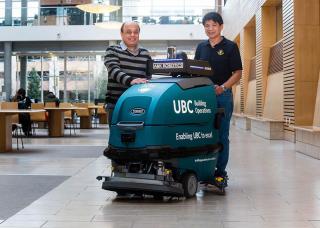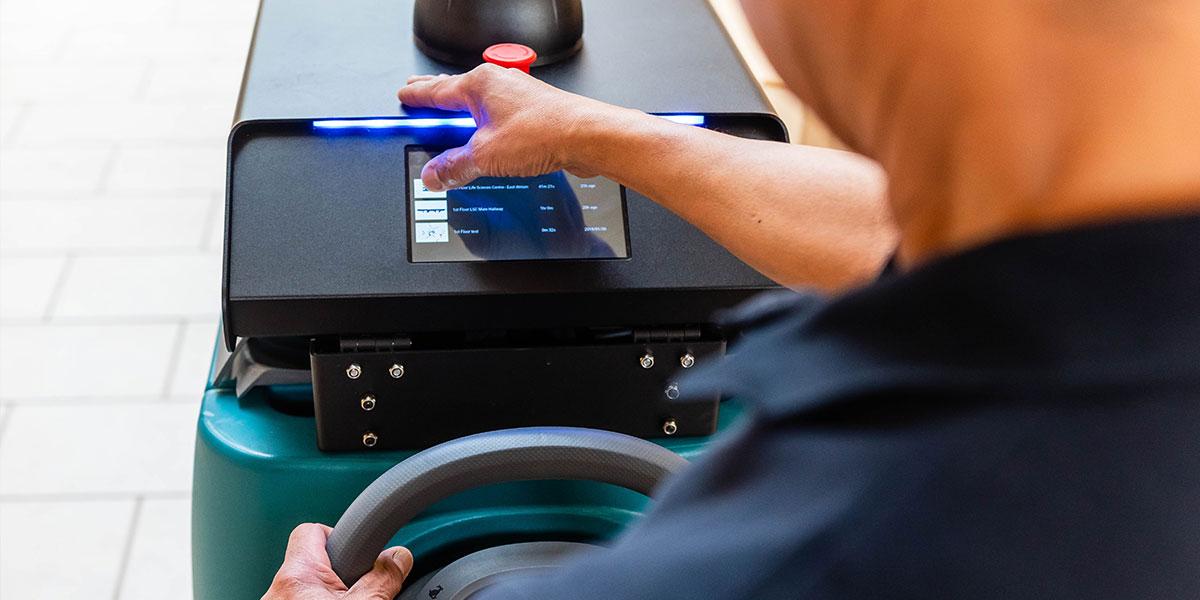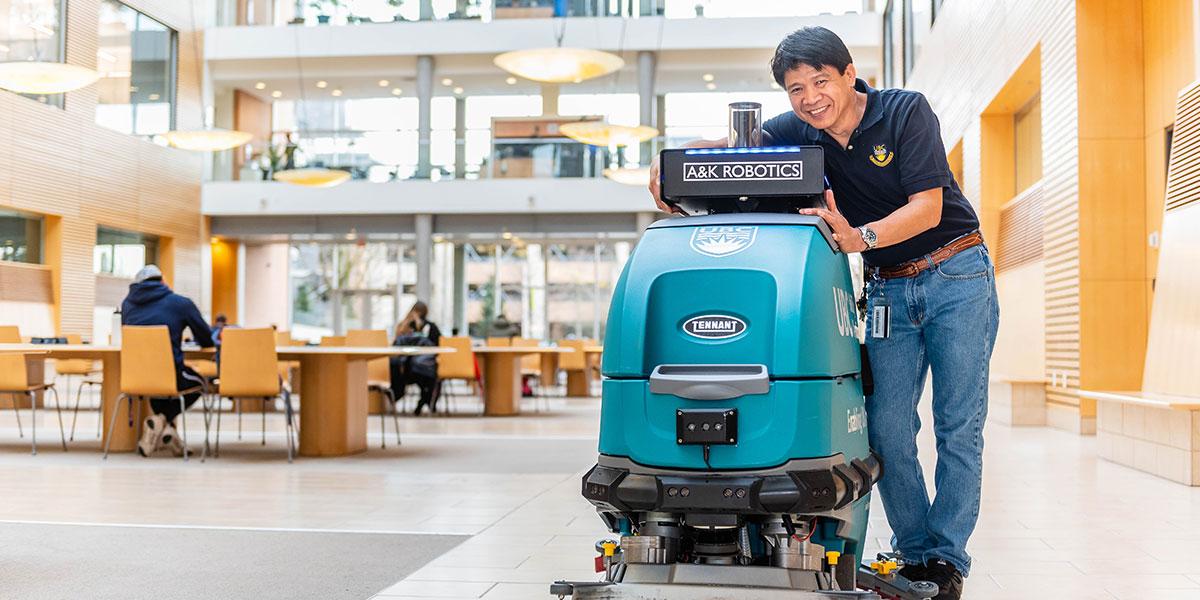How to train your robot


When Gurpreet Gill first started at UBC as a custodian in 1989, the Vancouver campus had half the number of students, only a handful of restaurants, and parking cost 25 cents a day. A lot has changed in 29 years for the now Custodial Head Supervisor, including the recent addition of two new team members.
“We are lucky enough to have a countess and baroness working with us,” Gurpreet laughs, referring to the names given to the first two robotic floor scrubbers introduced on campus last October.
“This is one of the many things I love about UBC, and what keeps me here after all these years,” he continues. “Things are always changing and there’s always a new challenge to overcome. It motivates me to keep learning and do a better job.”
Countess and Baroness actually started life as regular, manual floor scrubbers at UBC and were transformed into self-driving robots by A&K Robotics last year to support the work of Building Operations’ Custodial Services team. To create the robot, engineers from A&K – who are also UBC graduates and responsible for the robots’ quirky names – essentially installed a ‘brain’ on top of the machine. This intelligent navigation system, which is comprised of a computer with touchscreen and overlapping cameras with sensors, allows the scrubbers to be programmed, or trained, to clean along different paths.
“Training the robots is simple”, explains Gurpreet.
“All you do is select ‘add new path’ on the touch screen and then you manually drive the machine, showing it the path to follow, and it records it in its memory. Once you’re done, you press ‘stop’ and ‘save’. The robot is then able to clean this path by itself. We can edit paths or add news ones as needed.
“Having the robot on our team really does help our custodial staff. It saves them time, allowing them to do more detailed work or important preventative maintenance.”
Having the robot on our team really does help our custodial staff. It saves them time, allowing them to do more detailed work or important preventative maintenance.
Gurpreet Gill

Nestor Calivoso has worked as a custodian at UBC for 15 years and is currently in Gurpreet’s team based at the Life Sciences Building, where one of the robots works. The other robot works out of the Henry Angus Building.
“Countess is my work buddy; my partner,” he says. “It helps me a lot and makes my job easier. To put it to work in the east atrium, I fill it up with the cleaning solution and just press ‘go’ on the touchscreen. That’s it. I know it takes 40 minutes for it to wash the floor so I can just leave it and do other things like dusting or burnishing – jobs I sometimes need to rush or can’t get to.”
Nestor says the robot is of most help when a member of the team is sick or unable to work.
“Sometimes when my co-worker is not around we need to cover his area, and that can be challenging,” he says. “Now we can get the robot to do some of that work.”
Gurpreet adds, “Having the robots on the team doesn’t take work off the custodians and it doesn’t lead to more work either. It’s more about how do we best utilise their time now to do the best job we can. At the moment we’re saving about two hours a night, Monday to Friday, so what can we do with that extra time?”
Having the robots on the team doesn’t take work off the custodians and it doesn’t lead to more work either. It’s more about how do we best utilise their time now to do the best job we can.
Gurpreet Gill

While they are reliable and hardworking members of the team, there are some limitations to what the robots can do.
“Their battery-life, which is about 2.5 hours, will always be a consideration in how hard we can work them,” says Gurpreet. “Also, they can only work in large open spaces such as hallways or lobbies, in order to have enough space to turn without running into things. You can’t use them in most classrooms, laboratories, offices or washrooms.
“They have sensors which mean they will stop if something, or someone, gets in their way. They will just stand there – I like to believe they are thinking – and if there is no movement after a period of time they will move around it. But stopping constantly is not very efficient.”
Despite this, there are many spaces across the university that the custodial team would benefit from using the robotic floor scrubbers in the future. When you’ve got a team of 360 staff looking after 9 million square feet of space within 230 buildings, 24/7, a little help can go a long way.
“In buildings including the Student Rec Centre (SRC) and the Nest, there are lots of big open spaces where we could use a robot,” he says, adding five more robots are expected to start work in the coming months.
“During exams, the SRC building accommodates about 900 students. It’s a big space and a big job for the team to both set up for the exams and clean it every night. An auto scrubber could really help.
“We just need to work out a way for them to vacuum as well as wash the floors,” he jokes.
Reflecting on his time at UBC, Gurpreet, who received a President’s Staff Award in 2010, calls the campus “his home”. “It’s not where I live but where I spend most of my time. Both my children graduated from here, and one even works at UBC now. So it’s very much a part of my family. I love the work and I definitely have the best team, robots and all.”
I love the work and I definitely have the best team, robots and all.
Gurpreet Gill
Find the latest news, updates, events, and useful dates from across UBC, curated for faculty and staff by Internal Communications.
Access a library of resources from multiple UBC websites, all in one place.